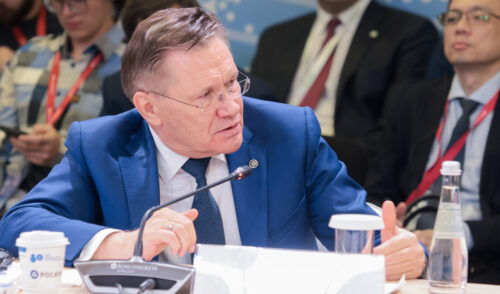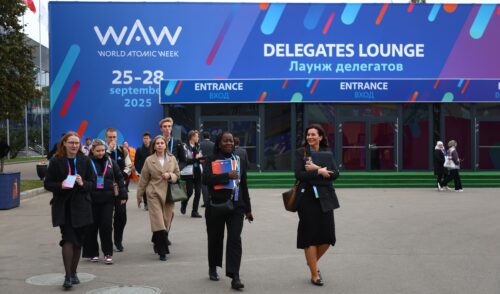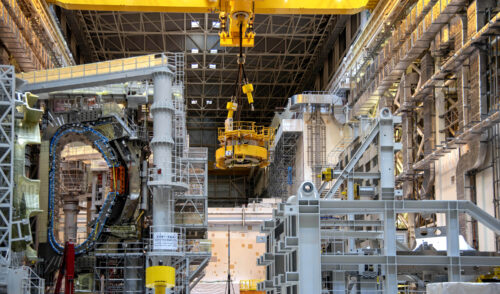
Rosatom in the Arctic
back to contents– Rosatom was represented by more than one group company at the International Arctic Forum. What are your basic lines of business in the Arctic?
– The Arctic is a region with a vast, yet untapped potential. First, it is rich in natural resources, but their development per se can deliver a huge boost to the national economy. Second, it is the Northern Sea Route offering expansion of Russia’s transit capacity. It holds much promise both for the national economy and Russia’s position on the international market. Third, it is about national defense and security. Rosatom is present in each of these areas and therefore takes much interest in this forum.
– Which of the areas you have mentioned is of the highest priority for Rosatom in the Arctic?
– They all are of equal importance for us; we have projects and boast achievements in each of them. Our flagship project is the Northern Sea Route. Rosatomflot [Russia’s nuclear fleet operator] gains momentum and will not lose it because year-round navigation on the Northern Sea Route is impossible without nuclear icebreakers. As for Russia’s largest Pavlovskoye deposit of lead-zinc ores, the project has more than regional or even national importance. It has great potential and excellent prospects.
– What does it mean that the Pavlovskoye deposit on Novaya Zemlya ‘has more than regional or even national importance’?
– A specific feature of the Arctic is that development of the Pavlovskoye deposit goes far beyond ore mining or processing. It will entail development of the archipelago, construction of a sea port infrastructure on the Yuzhny Island, inclusion of the new port into the Northern Sea Route, and new contracts for companies in the Arkhangelsk Region. In fact, the deposit becomes a local economic hub that will bring in more taxes on the municipal and regional levels, create new jobs and open up new prospects of the regional development. Proven lead and zinc reserves measure around 50 million tons. We think that, following detailed exploration, this figure is likely to double. Ores from the deposit also contain silver. These reserves are sufficient for 30–35 years of production at the Pavlovskoye deposit. I think, though, that the economic life of the deposit will be twice as long if we take into account total mineral resources available on Novaya Zemlya. Our key interest is zinc as it is used in many of Rosatom’s technologies and products. For example, zinc is used to increase the service life of primary loop piping and in high-precision medical equipment. It is also in demand in metallurgy. After the deposit reaches its designed capacity, we expect it to yield annually up to 65,000–70,000 tons of zinc concentrate. I believe that this total amount will find a buyer on the Russian market. I should also add that zinc is one of a few metals growing in price. It means the project has good economic prospects. By contrast, lead and lead concentrate are planned to be exported. We have already reached a preliminary agreement with China’s largest state-run steel manufacturing company and Sweden’s Boliden. Boliden has expressed its preliminary consent to being our partner in the lead concentrate processing and distribution on the European market.
– What is your estimate of lead concentrate exports to Asia and Europe?
– According to our preliminary estimates, about 50,000 tons of lead concentrate from Pavlovskoye will go to China and roughly 200,000–210,000 tons will be sent to Europe.
– At present, Rosatom is building three new icebreakers. Will they be enough to support major Arctic projects to be commissioned soon and deliver the company’s strategy for the Northern Sea Route? Does Rosatom consider placing orders for the fourth and fifth icebreakers?
– It is true that the icebreakers in operation – Vaygach, Yamal and Taymyr – will be decommissioned in the mid-term. We will take steps to extend their service life, but they will be nevertheless taken out of service in the 2020s. The 50 Let Pobedy nuclear icebreaker and the Sevmorput nuclear lighter will not be decommissioned. At present, the Baltic Shipyard is constructing a new line of nuclear icebreakers – Arktika, Sibir and Ural – to replace those in operation. We expect them to be accepted in 2019, 2020 and 2021 respectively. We look forward to receiving these icebreakers and hope that the shipbuilders will not let us down. This is our tomorrow, but we are already thinking about the day after tomorrow and have designed the next-generation nuclear icebreaker Lider (Leader). With a capacity of 110 MW, it is almost twice as powerful as the current generation and three times wider, thus being capable of escorting bigger vessels. I believe that further expansion of the icebreaker fleet should be based on more powerful vessels like Leader. It makes no sense to build one flagship vessel with no plans to build more, and we will need to construct three to five icebreakers of the new generation. In any way, we now have to make a decision about when to lay the keel of Leader.
– How much cargo did the nuclear fleet escort through the Northern Sea Route in 2016? What is your forecast for 2017 and for the medium term till 2025?
– In 2015, Rosatom’s nuclear fleet escorted 195 vessels with a total capacity of 2 million tons. In 2016, the number rose to 410 vessels that carried 5.3 million tons of cargo. The year on year growth is more than twofold, and I expect it to continue into 2017 since we already have relevant contracts. We will see how it goes, though. We also believe that the freight traffic on the Northern Sea Route will reach 30 or even 35 million tons in 3–5 years. The best proof is that Novatek’s Yamal LNG and Gazprom Neft’s Novoportovskoye oil field projects already use it.
– Being in Arkhangelsk, it is reasonable to ask about Rosatom’s approach to organizing power supply in the Arctic region.
– Rosatom builds many power plants both in and outside Russia. However, technologies we use in nuclear power plants are too powerful for the Arctic. For instance, our flagship project Novovoronezh II Unit 1 launched in March has a capacity of 1,200 MW. We realize that projects with a capacity of over 1,000 MW are hardly suitable for the Arctic. This region needs power sources with a capacity that is often less than 100 MW, and mobility here is a key factor. We are now working hard to commission a floating power station in Pevek on the Chukotka Peninsula in 2019. Once implemented in the Russian Arctic, this project may well become exportable. But we should first try it in action in Russia before bringing it to the global market. We also have power plant designs with even lower capacities of 5–6 MW or 20–30 MW. These are movable – and even underwater – power plants to be used at offshore fields.
You can read the full interview here: http://tass.ru/opinions/interviews/4142888




